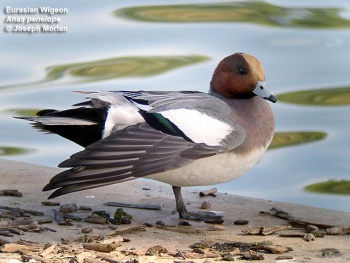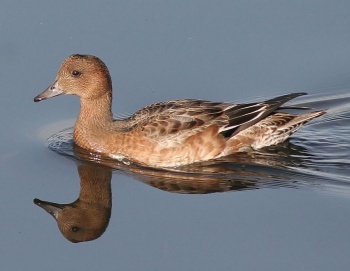- Mareca penelope
Identification

Photo © by Joseph Morlan
Lake Forest, California, USA, 29 November 2003
Length 42-51 cm (13.5 in), wingspan 73-82 cm (32 in), weight 415-970 g.
- Medium-sized dabbling duck
- Blue bill with black nail
- Legs and feet dark grey
- Dull green speculum on secondaries
- White belly
Adult male
- Orange-brown head with yellow-buff forehead stripe; often (but not always) a small iridescent green patch just behind the eye
- White secondary coverts
- Pink breast
- Grey flanks, mantle, and axillaries
- Scapulars striped white, black and grey
- Black hindquarters
- During eclipse in summer, like females except retaining the white forewing patch
Adult female
- Mottled dark brown body plumage with
- Rustier flanks
- Contrasting with paler head and neck
- Dusky eye patch
- Secondary coverts greyer than male
Juvenile
- Similar to adult female
- First-winter males similar to adult males but lack the white forewing patch until late winter or spring
Similar species
American Wigeon is structurally and behaviourally very similar. Males differ in having pinkish flanks, a white forehead stripe, and a larger and more obvious iridescent green patch behind the eye. Female and juvenile plumages virtually identical; best distinction is the white axillaries, visible when the wing is lifted during preening or in flight, while in close views, the secondary coverts are paler in American Wigeon.
Distribution
A common summer visitor to the north of the Palearctic region, breeding in Iceland and northern Britain, throughout most of Scandinavia (rarely in Denmark and southern Sweden) and across northern Russia to the Pacific. More scattered populations breed in Poland and the Baltic States, and occasionally a few breed south of main range in southern Britain and eastern Europe.
Present in breeding range from April to September, and widespread in winter and found along many coastlines and floodplains from Iceland, the British Isles and Denmark south to the North African coast. Also around the Black and Caspian Seas and in southern Iraq and eastwards across temperate Asia. Small numbers occur in Subsaharan Africa and Arabia.
Vagrancy
Vagrants have been recorded on the Azores and Madeira, Borneo, Sulawesi and Hawaii. Regular in small numbers on both coasts of North America and a common migrant through the Aleutians.
Taxonomy
This is a monotypic species[1].
Formerly placed in the genus Anas. Closely related to American Wigeon, and hybrids are recorded frequently where vagrants of either have settled in the "wrong" continent.
Habitat
Breeds in dense cover close to freshwater lakes and marshes in open and sometimes wooded areas. Highly gregarious in winter around estuaries and on coastal grassland. Grazes on pastures as well as feeding in shallow water and often associates with Brent Geese and Whooper Swans in estuaries and on coastal farmland.
Behaviour
Flocks readily with other ducks, particularly Common Teal and Gadwall, and also with Eurasian Coots.
Diet
Grazes, often at night but also during the day, on land on short grass (often among sheep) and young crops like oilseed rape. Also dabbles and dives for plants and roots, including Zostera eelgrass on tidal mudflats.
Breeding
The nest is laid beside a fresh water body in reeds, grass or heather. There is a single clutch laid between April and June. The ten to twelve eggs are plain creamy white or buff..
Vocalisation
Rising whistling contact call is distinctive and unique.
References
- Clements, J. F., T. S. Schulenberg, M. J. Iliff, D. Roberson, T. A. Fredericks, B. L. Sullivan, and C. L. Wood. 2018. The eBird/Clements checklist of birds of the world: v2018. Downloaded from http://www.birds.cornell.edu/clementschecklist/download/
- Swain, H. D. (1984) The Observer's Book of Birds' Eggs, Warne ISBN 0723200602
- Carboneras, C., Christie, D.A. & Kirwan, G.M. (2019). Eurasian Wigeon (Mareca penelope). In: del Hoyo, J., Elliott, A., Sargatal, J., Christie, D.A. & de Juana, E. (eds.). Handbook of the Birds of the World Alive. Lynx Edicions, Barcelona. (retrieved from https://www.hbw.com/node/52862 on 5 April 2019).
- González, J., H. Düttmann, and M. Wink (2009). Phylogenetic relationships based on two mitochondrial genes and hybridization patterns in Anatidae. Journal of Zoology 279 (3):310-318.
- Mini, A. E., E. R. Harrington, E. Rucker, B. D. Dugger, and T. B. Mowbray (2014). American Wigeon (Mareca americana), version 2.0. In The Birds of North America (A. F. Poole, Editor). Cornell Lab of Ornithology, Ithaca, NY, USA. https://doi.org/10.2173/bna.401
Recommended Citation
- BirdForum Opus contributors. (2025) Eurasian Wigeon. In: BirdForum, the forum for wild birds and birding. Retrieved 11 May 2025 from https://www.birdforum.net/opus/Eurasian_Wigeon
External Links
GSearch checked for 2020 platform.1






